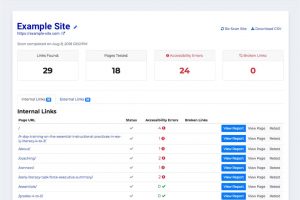Web Accessibility Lawsuits and Key Takeaways You Should Know 2020

By Sam Stemler on Dec 4, 2019
As the World Wide Web becomes increasingly important in everyday life, web accessibility is a growing concern for many users and many businesses. In an effort to use the web equally with abled users, many disabled users and advocates have filed accessibility lawsuits against businesses that do not have accessible websites. Businesses large and small can learn from high-profile web accessibility lawsuits. These are the most prominent recent cases as of the start of 2020, with more likely on the way.
Web Accessibility Standards and Rules
The Web Content Accessibility Guidelines (WCAG), developed by the World Wide Web Consortium, are the most widely-accepted web accessibility standards around the world. There are three levels of WCAG compliance: A, AA and AAA. Generally, WCAG AA compliance is considered acceptable web accessibility for most legal purposes around the world, including the USA.
In America, Section 508 of the Rehabilitation Act of 1973 is based on WCAG 2.0 AA, mandating that all federal agencies and any local or state resources receiving federal funding must comply with its rules. Many other countries have passed similar policies, using WCAG 2.0 AA as the standard for compliance.
The Americans with Disabilities Act
Another rule which governs accessibility in America, the Americans with Disabilities Act (ADA), is somewhat less clear. ADA Title III regulations mandate that businesses must make their physical locations accessible, but the law was written before the internet became widely-used, so it does not mention this aspect. This has created a grey area now dependent on case law, and it has resulted in thousands of lawsuits. The outcomes of these web accessibility lawsuits have helped to inform the outcome of others, and continue to shape web accessibility in America.
Avoid lawsuits and manage accessibility on your site. Download the Ultimate Web Accessibility Checklist >
The Top 5 Web Accessibility Lawsuits
In 2018 alone, over 2,250 web accessibility lawsuits were filed. From 2017 to 2018, the number of web accessibility lawsuits jumped 177%, and this number is expected to rise 7% again once 2019’s lawsuits are tallied. These cases include small businesses as well as some of the most well-known brands worldwide, and span every industry. 2019 was an important year for web accessibility legislation, including the first case approaching the Supreme Court. Let’s review some of the most impactful web accessibility lawsuits of the last decade, and take a look at what’s to come in 2020.
1. NAD v Netflix (2012)

In 2012, Netflix was not what it is now at the start of 2020. However, the NAD v Netflix case was a landmark web accessibility lawsuit. It was to be one of a number for Netflix, which would struggle in later years with multiple accessibility issues. In this case, the National Association for the Deaf filed suit against Netflix in Massachusetts, claiming Netflix did not provide equal services for customers with hearing loss or deafness. A Massachusetts judge ruled that services that existed solely or mostly online were not exempt from ADA requirements. This was a fairly new position, and would affect a wide range of businesses in later years.
2. Gil v Winn-Dixie (2017)
This case was among the first in thousands of similar web accessibility cases to be filed. In Florida, Juan Carlos Gil filed suit against the Winn Dixie grocery chain, claiming their website was not accessible to visually-impaired users. The Gil v Winn-Dixie case went to trial, unlike many other, similar cases which were settled out-of-court. The judge ruled in favor of Gil, explaining, “Winn-Dixie has violated the ADA because the inaccessibility of its website has denied Gil the full and equal enjoyment of the goods, services, facilities, privileges, advantages or accommodations that Winn-Dixie offers to its sighted customers.” This case set a precedent in Florida that business’ websites must have equal accessibility.
3. Markett vs. Five Guys Enterprises (2017)

You might be familiar with a term in criminal law known as “double jeopardy,” ensuring that no one can be tried for the exact same crime twice. However, in civil court, the rules are a bit different. Burger chain Five Guys Burger and Fries found this the hard way in 2017 when they were sued for web accessibility while in the middle of revamping their site for accessibility.
This may seem unfair, but makes sense in some cases. Most web accessibility cases—and many other civil court cases—demand corrective action, not money. If a business was sued and ordered to make their site accessible, but then failed to do so, a second suit may be needed. Whether or not this was true for Five Guys, this case also highlighted the importance of being proactive when it comes to web accessibility.
5. Mendizabal v. Nike Inc. (2017)
Maria Mendizabal filed suit against Nike and several other prominent businesses in 2017 due to a lack of website accessibility for low-vision users. Nike is one of dozens of fashion businesses sued for inaccessibility, and most of these cases share common elements; the websites don’t work with screen readers, they lack alt-text and use empty links. These are some of the most common web accessibility issues across the internet and these suits highlight the importance of checking for these issues.
5. Robles v Domino’s Pizza LLC (ongoing)

The Domino’s v. Robles case may be the most important web accessibility case in American history so far. Beginning in California, this case nearly made it to the Supreme Court, where the rules on web accessibility and business’s obligations would’ve received much-needed clarification. However, the Supreme Court declined the case, moving it back to trial in a lower court. With the previous and most-recent ruling from the Ninth Circuit Court in favor of the plaintiff, the overall takeaway supports web accessibility requirements under the ADA. However, with no overreaching federal verdict on the subject, it will be left to state courts to interpret the ADA. This means there will likely be more web accessibility lawsuits in 2020.
3 Key Takeaways from Web Accessibility Lawsuits
1. Use Testing Tools and Fix Common Problems

For businesses worried about the web redesign expenses and legal hot water, web accessibility can seem like an excessive requirement. However, many of the websites facing the legal microscope lack the same elements, and these are relatively easy to fix. Automatic testing tools can detect many of these problems, and they can be fixed by simply inserting some text.
Websites undergoing legal scrutiny tend to lack these elements:
- No alt-text for images or graphics
- Empty links without text
- Redundant links
2. Be Proactive and Consistent
The Markett vs. Five Guys Enterprises case shows that a business can be liable even when they are undergoing website improvements. The best way to avoid an expensive legal suit—or multiple suits—is to be proactive. Test your site early, correct problems, and test it regularly to ensure it remains accessible as you add content and make changes. You wouldn’t open a store or restaurant before making sure it was ADA-compliant and accessible to all patrons, and it’s becoming clear that websites should receive the same attention.
3. Work With Web Accessibility, Not Against It
Businesses across every industry, from transportation to retail to fashion to food, have tried and failed to get around web accessibility requirements. Arguments that equal services are provided elsewhere, or that the business does (or doesn’t) operate a physical space and therefore does not need an accessible website, or that the website is not an important part of the business, have not held up in a courtroom. You’ll save time, money and energy—and enjoy a better public image—by simply making your site accessible, instead of trying to work around it.
Web accessibility and the law can seem confusing at first. Though there is not (yet) a decisive federal ruling, a growing number of state cases indicate that ADA regulations apply to websites as well as physical spaces. To avoid unnecessary lawsuits and open your site to all visitors, make web accessibility a priority in 2020. Get started with the Ultimate Web Accessibility Checklist and you may be surprised at how easy web accessibility can be.
